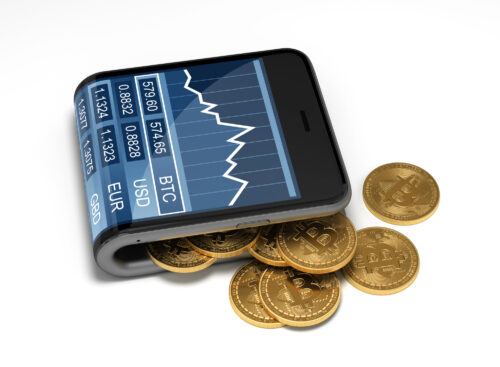As the cryptocurrency market matures, digital asset theft remains one of the biggest concerns for investors.
Hacking and phishing attacks can claim your digital assets in mere moments, which is why protecting what’s yours is more important than ever. in the past year alone.
With DeFi becoming even more popular, new options flood for safeguarding crypto with each passing day.
Discerning what’s best for you becomes even more challenging as the space gets noisier.
This guide helps both beginners and seasoned investors understand how to choose a wallet that balances security, usability, and control.
What Are Crypto Wallets?
A cryptocurrency wallet is a tool that allows users to interact with blockchain networks. These wallets enable the storage, sending, and receiving of digital currencies like Bitcoin and Ethereum.
Importantly, wallets do not store the actual cryptocurrency. Instead, they store private keys, which act as digital signatures to authorize transactions.
There are two main types of crypto wallets: hot wallets and cold wallets. Hot wallets remain connected to the internet and are known for their convenience. They’re ideal for frequent transactions but are more vulnerable to hacks.
Cold wallets, on the other hand, operate offline, offering greater security but less ease of use. Understanding this distinction is crucial for determining the right wallet type for your needs.
Key Features of a Secure Crypto Wallet
Strong Encryption
Encryption is the backbone of wallet security. It ensures that private keys and sensitive user information remain safe from hackers. A secure wallet uses advanced encryption standards like AES-256, a protocol trusted across industries for its robust protection.
Two-Factor Authentication (2FA)
Two-factor authentication adds an extra layer of defense. It requires users to verify their identity using a secondary method, such as a code sent to a mobile device. This significantly reduces the chances of unauthorized access, even if login credentials are compromised.
Backup and Recovery Options
Accidents and device failures can happen at any time. Secure wallets offer recovery phrases, typically 12 or 24 words, that allow users to regain access to their funds. This feature ensures that even if a wallet is lost or damaged, the assets are not permanently gone.
Private Key Ownership
One of the most critical aspects of wallet security is private key control. Secure wallets give users full ownership of their private keys, unlike custodial wallets managed by exchanges. This prevents third parties from having access to your funds.
Regular Software Updates
Cybersecurity threats evolve constantly. Reliable wallets frequently update their software to address vulnerabilities. These updates often include new features, performance improvements, and enhanced security measures.
Reputation and Reviews
The reputation of a wallet provider speaks volumes about its reliability. Wallets with consistently high ratings and positive user feedback are safer bets. Conducting research and reading independent reviews can help identify trustworthy options.
Types of Crypto Wallets Explained
Different investors have different needs, and understanding the various types of crypto wallets is essential for selecting one that fits your investment goals and risk tolerance.
Each wallet type offers unique advantages, security trade-offs, and use cases.
Below, we break down the four primary types of wallets with updated 2025 insights and expert recommendations.
Hardware Wallets (Cold Wallets)
Hardware wallets are physical devices that store your private keys completely offline, making them immune to online hacking attempts.
The top models in today’s market dominate due to their EAL5+ certified Secure Element chips, encrypted firmware, and strong reputations for safety.
These wallets connect to computers or smartphones only when signing transactions, meaning your private keys never touch the internet.
They are ideal for long-term investors, institutional holders, or anyone storing significant crypto balances.
While they come at a cost, usually between $70 and $200, their tamper-resistant construction and regular firmware updates make them the gold standard for self-custody.
Some even integrate Bluetooth connectivity and mobile apps for convenience without compromising on safety.
Software Wallets (Hot Wallets)
Software wallets are applications installed on a desktop or mobile device that store your crypto keys digitally.
Because they connect to the internet, they are often referred to as hot wallets. They offer an excellent balance between usability and accessibility, particularly for traders and those who interact frequently with decentralized applications (dApps).
Popular options support thousands of tokens across multiple blockchains, making them versatile tools for DeFi enthusiasts.
The trade-off, however, is security: since these wallets are online, they’re more vulnerable to phishing, malware, and keylogging attacks. Modern hot wallets now integrate with hardware devices or multi-factor authentication systems to mitigate these risks.
Paper Wallets
Paper wallets are one of the earliest forms of cold storage, literally a printed copy of your public and private keys, usually displayed as QR codes.
While once considered a cheap and secure way to store crypto offline, paper wallets have fallen out of favor due to the high risk of physical loss, water damage, or printing errors.
However, for advanced users seeking deep cold storage, long-term, untouched crypto holdings, paper wallets still provide an air-gapped solution.
In 2025, users generating paper wallets should always do so on an offline computer using trusted open-source tools and print on archival-quality, acid-free paper or metal sheets for durability.
To further enhance safety, store them in multiple secure, geographically separate locations like safe deposit boxes.
Despite their limitations, they remain a cost-effective, low-tech option for storing cryptocurrencies securely when executed properly.
Multi-Signature Wallets
Multi-signature, or multi-sig, wallets require multiple private keys to authorize a transaction.
This approach distributes control among several users or devices, making unauthorized transfers nearly impossible.
They are especially valuable for organizations, DAOs, and families sharing digital assets.
For instance, a 3-of-5 multi-sig wallet requires three out of five authorized parties to approve any transaction.
The best options available today feature user-friendly interfaces, recovery options, and robust on-chain transparency.
Multi-sig wallets can combine with hardware or software wallets, further strengthening protection.
Top 6 Most Secure Crypto Wallets in 2025
The cryptocurrency landscape in 2025 continues to evolve rapidly, with security taking center stage for investors.
The rise of sophisticated phishing attacks, malware designed to steal seed phrases, and exchange breaches has made owning a secure wallet an absolute necessity.
The wallets highlighted below represent the pinnacle of crypto security, each with proven track records, robust encryption, and community trust.
Ledger Nano X
The Ledger Nano X remains one of the most advanced and trusted hardware wallets in 2025, balancing high-end security with user-friendly features.
It uses a Secure Element (CC EAL5+) chip, the same security standard found in passports and credit cards, ensuring that private keys never leave the device.
Ledger supports over 5,500 cryptocurrencies, including Bitcoin, Ethereum, and Solana, and integrates directly with Ledger Live, a native app that lets users stake, swap, and monitor their assets safely.
Ledger also regularly undergoes independent security audits, with its firmware being cryptographically signed to prevent tampering. In response to prior phishing incidents, Ledger has introduced Ledger Recover, an optional encrypted key recovery service.
Cypherock X1 Decentralized Hardware Wallet
The Cypherock X1 is one of the most advanced decentralized hardware wallets introduced in 2025, redefining digital asset custody through distributed key storage.
Unlike traditional wallets that rely on a single recovery seed, Cypherock X1 eliminates the single point of failure (SPOF) by splitting the private key into five cryptographic shards using Shamir’s Secret Sharing (SSS).
One shard resides in the X1 Vault, while four are stored separately across NFC-based smartcards equipped with EAL 6+ secure elements, the same bank-grade security used in modern payment systems.
To authorize transactions or recover access, any two of the five components are sufficient, ensuring redundancy and resilience.
This design guarantees that private keys remain fully offline, even if the connected PC is compromised.
The wallet’s companion app, cySync, supports Windows, macOS, and Linux, allowing users to manage over 18,000 cryptocurrencies and tokens, including BTC, ETH, BNB, SOL, and USDT.
Trezor Model T
Developed by SatoshiLabs, the Trezor Model T is completely open-source, meaning its code and firmware can be audited by anyone, which reinforces trust among developers and security researchers.
It features a bright touchscreen display, allowing users to input PINs and passphrases directly on the device, eliminating the risk of keylogging attacks.
It supports over 1,400 cryptocurrencies, including major assets like Bitcoin, Ethereum, and stablecoins. One of its biggest advantages is its compatibility with third-party wallets such as Electrum and Exodus, enabling seamless portfolio management.
Additionally, Trezor integrates Shamir Backup, a powerful security protocol that splits your recovery seed into multiple shares stored in separate locations.
SafePal S1
Unlike many competitors, SafePal S1 is completely air-gapped, meaning it never connects to Wi-Fi, Bluetooth, or USB during transactions. Instead, it relies on encrypted QR codes to sign and verify transactions, ensuring private keys remain offline.
The device supports over 30 blockchains and 10,000 tokens, making it an excellent option for users active in DeFi and NFT ecosystems.
Plus, SafePal’s built-in self-destruct mechanism automatically wipes all data if it detects any physical tampering attempts, providing an extra layer of safety.
It’s lightweight and portable, though its smaller screen might be less convenient for heavy users.
The SafePal mobile app also enables users to monitor portfolios, swap assets, and stake coins while maintaining strong offline protection.
Keystone Pro (formerly Cobo Vault)
The Keystone Pro is designed for maximum security, offering air-gapping while supporting QR code signing, completely isolating it from network-based attacks.
Its robust metal casing makes it tamper-proof and resistant to environmental damage such as fire and water.
Keystone Pro also supports multi-signature transactions, biometric verification, and open-source firmware, appealing to security-focused investors.
It’s compatible with leading wallets like MetaMask, Electrum, and BlueWallet, ensuring flexibility across ecosystems.
The large touchscreen display enhances usability, while a built-in fingerprint sensor secures access and has three seed phrases to enhance its protective measures.
Electrum
Electrum is one of the oldest open-source wallets, first launched in 2011, and has maintained a reputation for security, speed, and reliability. As a desktop software wallet, it’s favored by advanced users who value full control over their private keys.
It supports features such as multi-signature transactions, cold storage compatibility, and hardware wallet integration with devices like Trezor and Ledger.
Because it’s open-source, its code has been reviewed extensively by the community, ensuring transparency and long-term trust.
Electrum also allows users to set custom transaction fees, connect to their own Bitcoin node for maximum privacy, and use seed phrases for recovery.
Its lightweight design ensures quick synchronization without downloading the full blockchain.
Though its interface can feel technical for beginners, Electrum’s unmatched flexibility and strong security tools make it ideal for Bitcoin purists and privacy enthusiasts.
How to Choose the Right Wallet for You
Selecting the right crypto wallet depends on your investment strategy, technical expertise, and the level of security you require.
With hundreds of options available, understanding your own use case is the first step to narrowing down your choice.
Here, we break down key considerations and wallet recommendations based on investor type, trading habits, and security priorities.
Understanding Your Investment Profile
Your investment profile determines how much risk you can tolerate and how frequently you’ll need to access your funds.
Long-term holders, often called “HODLers,” prioritize cold storage and maximum security over convenience like the Ledger Nano X, Trezor Model T, or Keystone Pro.
On the other hand, active traders who move funds daily benefit from hot wallets such as MetaMask, Trust Wallet, or Exodus, which offer rapid transactions and integration with decentralized exchanges (DEXs).
Matching your risk tolerance to your wallet’s security profile is key to maintaining both safety and usability.
Security vs. Convenience
Every wallet type strikes a balance between convenience and security. Hardware wallets are inherently safer because they store private keys offline, isolating them from potential online threats.
However, they require physical handling and are less practical for frequent transactions.
Hot wallets, by contrast, prioritize speed and ease of access but introduce greater vulnerability through their internet connectivity.
For 2025, hybrid setups have become popular, using a hot wallet for small, daily transfers and a cold wallet for long-term storage.
This two-tier system helps investors manage liquidity without sacrificing asset protection.
Whichever wallet you choose, ensure it supports multi-factor authentication (MFA), encryption, and recovery phrase protection, as these are non-negotiable for modern crypto security.
Evaluating Compatibility and Ecosystem Integration
As blockchain ecosystems diversify, wallet compatibility has become a vital factor.
If you actively participate in DeFi, NFTs, or staking, you’ll want a wallet that supports multiple blockchains and smart contracts.
Consider the wallet’s ability to connect seamlessly with your exchange or Web3 ecosystem, without requiring third-party intermediaries.
In 2025, wallets with cross-chain bridges and dApp browsers are particularly valuable for investors managing diverse portfolios.
Budget and Value Considerations
Wallets vary widely in cost, ranging from free open-source software like Electrum to premium hardware devices costing $200 or more.
While budget constraints are valid, price should never outweigh security. Investing in a high-quality hardware wallet can prevent catastrophic losses due to hacks or phishing attacks.
For example, losing $100,000 in crypto because of a $150 wallet saving is a risk not worth taking. If you’re on a tight budget, combining a free software wallet with multi-signature security or an older hardware model can provide a balance between cost and protection.
Always purchase hardware wallets directly from the manufacturer or verified resellers to avoid counterfeit devices.
Backups, Recovery, and Support
Even the best wallets are useless without a reliable recovery plan. Always ensure your chosen wallet provides a 12–24 word recovery seed, and you can store it safely offline.
For long-term security, consider metal backup plates that resist fire and corrosion. Some hardware wallets divide your recovery key into multiple parts to be stored in different locations — a safeguard against loss or theft.
Moreover, responsive customer support and active user communities can make a significant difference in solving technical issues quickly.
Check whether the wallet provider offers multilingual support, firmware updates, and verified help centers to reduce downtime and risk during emergencies.
Crypto: Common Mistakes to Avoid
Even the most advanced crypto wallets can fail to protect your assets if used incorrectly.
In 2025, cybercriminals have evolved with increasingly sophisticated tactics, targeting both new and experienced users. Understanding the most frequent wallet-related mistakes can help prevent devastating losses.
Below, we expand on the critical missteps investors make and provide actionable guidance for avoiding them.
One of the most dangerous and often overlooked mistakes is purchasing a hardware wallet from unauthorized marketplaces or resellers.
Fraudsters have been known to tamper with devices, pre-configure seed phrases, or insert malware that compromises private keys once connected.
Always buy directly from the manufacturer’s website or verified distributors. Before setting up the device, ensure it arrives sealed and unused.
Your wallet should include tamper-evident packaging and serial verification processes.
If any packaging appears altered, contact the manufacturer immediately. A few dollars saved by purchasing from a reseller is not worth risking your entire portfolio.
Ignoring Crypto Firmware and Software Updates
Failure to update your wallet’s firmware or application software is a common and costly error. Manufacturers frequently release patches to fix vulnerabilities or strengthen encryption algorithms.
Outdated firmware can expose users to zero-day exploits that hackers exploit quickly once vulnerabilities are made public.
Make it a habit to check for official updates at least once every two months and verify release notes on the company’s official website before installing. Updated software ensures compatibility, security, and optimal wallet performance.
Crypto Storing Recovery Phrases Unsafely
Your recovery phrase, or seed phrase, is the ultimate key to your cryptocurrency. Storing it digitally, such as in cloud storage, screenshots, or notes apps, invites disaster.
Cloud accounts are frequent hacking targets, and even encrypted backups can be breached.
The best practice is to record your recovery phrase offline, preferably on metal seed backup plates resistant to water, fire, and corrosion.
Additionally, store copies in geographically separate secure locations, such as safes or safety deposit boxes.
Some users divide the phrase into segments for additional protection. Remember: anyone with your seed phrase can take your funds instantly and irreversibly.
Falling Victim to Phishing and Impersonation Scams via Crypto
Phishing remains one of the most prevalent threats in 2025. Scammers now deploy deepfake videos, fake wallet support websites, and cloned apps to trick users into revealing private information.
Common red flags include urgent requests, typos in domain names, or unsolicited emails claiming wallet issues.
Always verify URLs manually, bookmark official pages, and never share your seed phrase, even with someone claiming to represent a wallet company.
Modern browsers now feature integrated anti-phishing tools, and using password managers can help detect fake login pages. If unsure, double-check any wallet communication by contacting official support through verified channels.
Reusing Wallet Addresses or Private Keys
Reusing addresses or sharing private keys across multiple wallets increases your exposure to tracking and theft.
Each transaction on a blockchain is public and traceable, meaning reusing addresses can compromise anonymity and potentially allow attackers to correlate your identity with your funds.
Modern wallets automatically generate new addresses for every transaction—always use them.
Avoid exporting or importing private keys between platforms unless absolutely necessary. If you must use the same wallet across devices, rely on secure recovery phrases rather than key file transfers to minimize the risk of interception.
Neglecting Physical Security
While digital threats are well known, physical risks are equally important. Hardware wallets can be stolen, misplaced, or destroyed. Always store them in a safe, preferably fireproof and waterproof.
If traveling, avoid public Wi-Fi when managing crypto and keep your hardware wallet disconnected unless needed. Use tamper-proof bags or protective cases to detect unauthorized handling.
For maximum safety, consider using multi-signature wallets, where multiple devices or users must approve any transaction, rendering a stolen device useless on its own.
Pro Tips for Maximum Security with Crypto
- Use a Dedicated Device for Crypto Transactions: A dedicated device reduces exposure to malware and phishing attempts. Avoid using this device for general web browsing or downloading apps.
- Regularly Monitor Wallet Activity: Frequently check your wallet transactions for unauthorized activity. Early detection can prevent further losses in case of a breach.
- Avoid Public Wi-Fi Networks: Public Wi-Fi connections are often unsecured and can expose your data to hackers. Use a VPN or mobile data when accessing your wallet.
- Consider Multisignature Wallets: Multisignature (multisig) wallets require approvals from multiple keys to complete a transaction. This adds an extra layer of protection, especially for large holdings or shared accounts.
- Diversify Your Storage Methods: Don’t put all your funds in one wallet. Using multiple wallets diversifies risk. For instance, keep a hardware wallet for savings and a mobile wallet for daily transactions.
Conclusion
As the cryptocurrency industry continues to mature, the importance of wallet security cannot be overstated.
Your crypto wallet is not merely a tool, it’s the foundation of your financial sovereignty. Understanding the distinctions between hardware, software, paper, and multi-signature wallets empowers you to make informed decisions based on your investment goals and risk tolerance.
The wallets featured in this guide, Ledger Nano X, Cypherock X1, Trezor Model T, SafePal S1, Keystone Pro, and Electrum, represent the highest standards of security and reliability available today.
Each excels in different areas, from open-source transparency and hardware encryption to affordability and user experience. However, even the best wallet is only as secure as the habits of its user.
Regular firmware updates, proper recovery phrase management, and ongoing vigilance against phishing attempts are essential practices for safeguarding your assets.
For new investors, starting with a user-friendly wallet such as Trust Wallet or Exodus provides an excellent entry point into self-custody.
Advanced users and institutions should explore hybrid setups combining cold and hot wallets for layered protection.
No matter where you fall on the experience spectrum, prioritizing security will always be the best investment decision you can make.





 Tags:
Tags:










